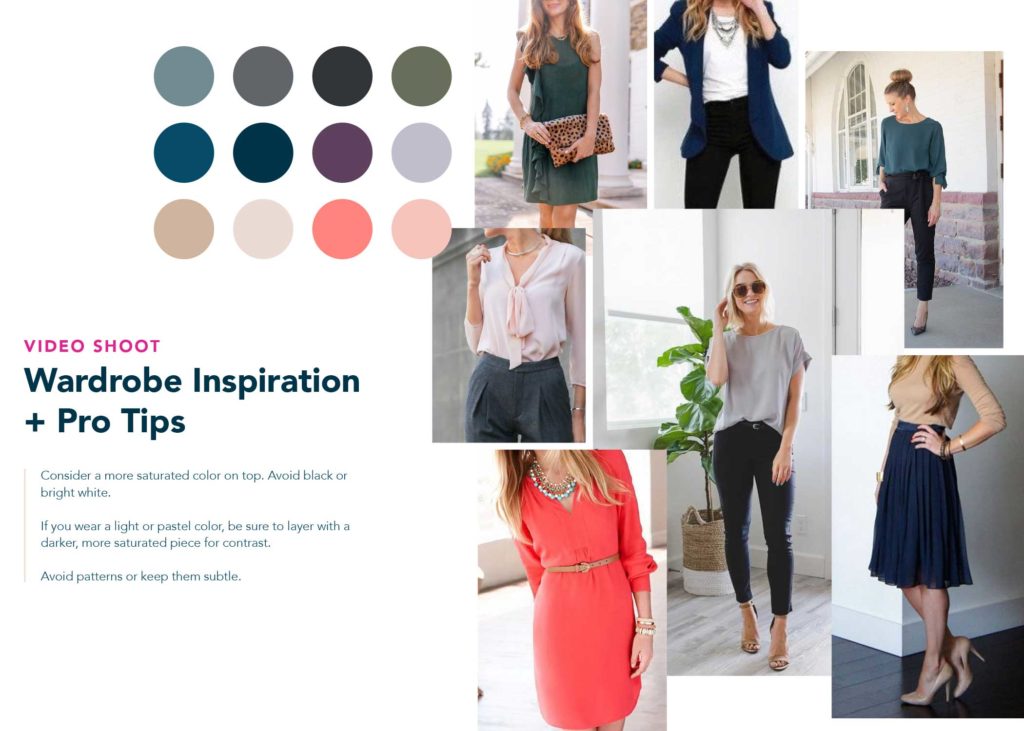If we say the words “video shoot” do you automatically break out in hives? We get it, being front and center with a camera in your face is not everyone’s happy place. As marketing communications pros, we’re most in our sweet spot writing the talking points, providing on-camera direction and creating beautiful graphics to animate on-screen.
But, marketers must market themselves too. Thus, the Raven Creative team found ourselves smiling for our close-ups recently as we filmed a company overview video. And guess what?! The world didn’t end, and even the most camera shy of our flock had some fun with it.
The best way to overcome filming fear is to be prepared. Here are 18 tips to make the most of your video shoot investment.
Pre-Shoot Prep
Start with strategy. What are the goals of your shoot? What final products are you hoping to leverage footage for? What are the key messages that you have to hit? Who is your target audience? If you have a communications strategy for your business, now is a great time to put it to work.
Prepare a script, story board and shot list. Even if you’re the world’s best on-the-spot speaker, don’t wing it. Have a safety net; you’re using far too many valuable resources (time, talent, budget, etc.) to freeze up when the camera starts rolling. Start out by writing a list of interview questions that cover all content bases for every potential use of footage. Be consistent with the question style and tone to help with continuity in the editing process. From there, script out all answers in their entirety. Whether this is farmed out among the team or all responses are written by one person, elect a final editor to ensure a consistent voice. Again, this will make the editing process run so much more smoothly when there are not stark contrasts between individual speakers. From there, create a story board to ensure everyone is on the same page with vision, and determine a supporting shot list to get you there.
Track down a teleprompter. If you don’t have the real thing, a tv or computer screen plugged into a laptop does the trick. Even if you’re planning on extemporaneous speaking or straight up memorization, make plans to have a teleprompter on hand, just in case.
Practice. Out loud, in front of someone. No matter how many times you’ve been to the rodeo, you never stop logging hours on the proverbial mechanical bull. The practice rule applies to everyone, no matter how seasoned you are.
Scout locations. After creating an exhaustive shot list for all interviews and b-roll, physically scout out locations ahead of time. Be mindful of light, excessive noise and visual distractions. Pay attention to the amount of prep it will take to transform the space to meet your needs, so a schedule can be made. When picking backdrops, be mindful of “empty space” to easily fill with on-screen animation, like title text, as appropriate.
Stage your shots. After you scout your locations, gather props to style the shots accordingly. From potted plants to wall art to branded swag – every item tells a story. Make sure everything in your shot is working together to tell the right one. Remove distracting elements or items that don’t represent your brand.

Prep your wardrobe. Wear something that makes you feel like your best self. When you look and feel good, you’re more comfortable and confident. Avoid crazy patterns, white, bright red and all-black outfits. Be mindful of jangly jewelry that the mic could pic up while recording. Consider the aesthetics of where the final product will be used. For example, if you’re embedding footage on your website, avoid any patterns that will clash with your site’s color palate. Consider pulling together a video styling inspiration sheet like this one to ensure that team wardrobe choices are cohesive and not distracting from messaging or the overall brand.
Bring everything. From extra batteries to a backup for your backup SD card, this is not a less is more occasion. It takes a lot of work to coordinate a shoot, and to make the most of your investment, it helps to be prepared. Print copies of shot lists and assign a team member to physically check them off throughout the shoot to ensure nothing is missed. Bring a back-up shirt in case of spills, a steamer for the wrinkles, a dryer sheet in case of static cling and hairspray to battle the fly-aways.
Get approvals. If you’re planning to obtain drone footage, be mindful of airport proximity. Drone operators with a Remote Pilot Certificate must get permission from air traffic control to fly in controlled airspace. In addition, work with your legal team to understand proper precautions/waivers regarding filming permissions. For example, what signage do you need to post when filming in a public place? What extra steps need to be taken when filming minors? Are there different rules for social media use?
On-Camera Tips
Silence all devices. Don’t be the person who ruins a perfectly good take with a buzzing phone. We’ve been that guy…it’s not fun.
Vary response delivery. If creating a montage or splicing together multiple perspectives, answer questions two ways, with an introduction that restates the question, and another version with just the answer. That way there are editing options for standalone answers and collective responses.
Be you…just a bit more of you. While it is important to be authentic, you may want to be a bit more animated than you would normally be with your voice and tone. While it may seem over the top, on camera it typically translates to the “normal” level of personal engagement that you would have if sitting across from someone during a conversation. Worry less about saying the perfect thing and more about sharing your wisdom and passion with others. When you’re speaking from that place, the rest tends to take care of itself.
Slow down. Reflective pauses and breathing are your friends! Don’t feel like you have to blurt out every piece of wisdom you have in the world’s largest run-on sentence. Pausing between thoughts provides natural editing breaks.
Shake it out. It’s okay to mess up! Take a breath, shake it out (literally, get up and move around unless your mic situation prevents it) and take it from the top.
Be conversational. If reading from a teleprompter, the trick is to act like you’re not. Be conversational and engaging – pretend that the teleprompter is a person that you are speaking to directly. Be aware of your gestures and how your eyes are moving across the screen…and don’t forget to blink. We recommend that the person being filmed directs their attention slightly off camera so they aren’t addressing the video audience directly. This provides the opportunity to make answers seem natural, even when reading from a script.
Hydrate. It can be soul crushing to hear your own voice crack on the last syllable of an otherwise perfect take. Even if you don’t feel like you need it, take regular sips of water between takes to keep things from drying out.
Exercise frame awareness. If you must move around during a take, know where the shooting frame starts and stops so you stay within it.
Blast some tunes. Loosen up by streaming upbeat music through a portable speaker between shots. It helps take the pressure off and allows you the chance to get out of your head.
Need to freshen up your site with some video personality? We can help!





